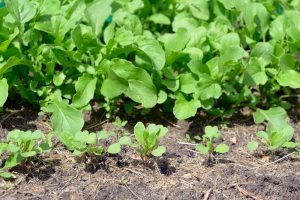This quick guide will assist you in planting and caring for your arugula, ensuring it becomes a flavorful and peppery nutritious addition to your home garden:
- Sunlight: Arugula thrives in cooler temperatures but still requires plenty of sunlight. Place the arugula seedling in a location that receives partial sun to full sun for about 4-6 hours per day.
- Temperature: Arugula is a cool-season crop and grows best in temperatures between 50°F to 65°F (10°C to 18°C). It can tolerate light freezes but will bolt (flowering and going to seed) quickly in hot weather. To discourage early bolting, keep arugula in afternoon shade when temperatures are above 85°F (29°C).
- Protection from Heat/Cold: In heat, consider providing shade or using shade cloth (with around 30-50% shading) to prevent the arugula from becoming stressed and bolting prematurely. In very cold conditions (below 32°F/0°C), extend the growing season by using frost cloth/row cover fabric or cold frames to protect the arugula from freezing temperatures.

For a continuous supply, plant arugula every two weeks, from early fall through late spring. - Watering: Keep the soil consistently moist. Water the arugula when the top inch of soil feels dry to the touch. Aim to provide deep, even watering to encourage healthy root development. Avoid overwatering, as arugula prefers slightly drier conditions compared to other greens.
- Soil and Fertilization: Arugula prefers well-draining soil with organic matter. Prepare the soil by adding compost before planting. Avoid heavy clay soils. Apply a balanced, slow-release fertilizer at planting to provide essential nutrients.
- Transplanting: Once your arugula seedling has grown a few inches tall and developed a couple of sets of true leaves, transplant it into a 1–2-gallon container with drainage holes or into a nutrient-rich garden bed. If planting in the garden, space each arugula plant 6-8 inches apart to allow for adequate growth and air circulation.
- Pests and Diseases: Watch out for common pests like aphids and caterpillars that may attack arugula. Consider using least-toxic pest control methods such as neem oil or growing a trap crop, such as radishes. Ensure good air circulation around the plants to prevent fungal diseases.
- Harvesting: You can start harvesting arugula leaves when they reach a usable size, usually around 2-3 inches long. Pick the outer leaves first, leaving the inner ones to continue growing. Regular harvesting encourages new leaf growth and prolongs the harvesting period.
- Succession Planting: Since arugula has a relatively short harvesting window, consider sowing seeds every few weeks for a continuous supply of fresh leaves throughout the growing season.
Remember that arugula is a fast-growing annual green, and its flavor is best when harvested young. With proper care and attention to its growing conditions, you’ll have delicious and nutritious arugula to add a peppery kick to your salads and dishes.
Fore more information on growing arugula, check out the UF/IFAS Gardening Solutions page on arugula: https://gardeningsolutions.ifas.ufl.edu/plants/edibles/vegetables/arugula.html
 2
2

